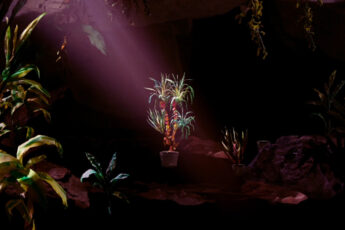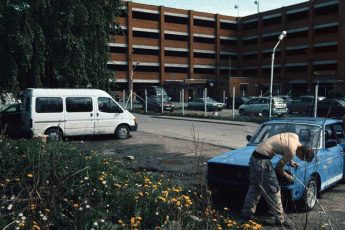Through Smoke and Sweat
Anna Hints’ Smoke Sauna Sisterhood (Savvusanna sõsarad, 2023)
Vol. 142 (February 2024) by Ana Grgić and Antonis Lagarias
on days I could not move
it was women
who came to water my feet
until I was strong enough
to stand
it was women
who nourished me
back to life
– Rupi Kaur, Sisters.
Anna Hints’ documentary Smoke Sauna Sisterhood opens with a series of silent shots of a woman who first lights a fire in a stove found in a small cabin surrounded by trees and then goes to collect water and tree branches. A group of women arrive, and, leaving their clothes behind, they enter the small cabin that turns out to be a sauna. These few shots introduce the first steps that one must take to enter the universe of a smoke sauna. The smoke sauna is a traditional practice in southeastern Estonia, which has been inscribed onto the UNESCO list of Intangible Cultural Heritage since 2014. The rest of the film mostly takes place inside the heated space of the sauna, while the few exterior shots show the passing of seasons, as different groups visit the sauna throughout the year, and images of a snow-covered forest alternate with the green colors of spring and the brown leaves of autumn. Inside the sauna, women not only relax and perspire together, but also share their most intimate stories, reflecting on them and listening to each other in silence. The film features many of the stories shared by different generations of women, and also documents specific actions that are central to the smoke sauna experience, such as collective singing, the use of water and tree branches to smooth out and loosen bare skin, and the making and circulation of smoke that at times conceals the women’s bodies and faces, blurring their vision as well as that of the viewers. Through these powerful and haptic visuals, the film manages to transpose the intimate and cathartic ambiance of the smoke sauna onto the screen and address the viewers’ minds and senses, much like the sauna experience is meant to relax both the body and the mind of those inside.
Smoke Sauna Sisterhood is Anna Hints’ feature debut. It premiered at Sundance in the World Cinema Documentary Competition, taking home the award for Best Director. The documentary has toured festivals across the world, winning the Best Baltic film award at the 27th Tallinn Black Nights Film Festival and then being named Best European Documentary at the European Film Awards in 2023. The director’s background in music and composition helps bring a multilayered, emotional, and intimate touch to the sound design, which helps catapult the spectators into the aural space of the sauna, which enhances the darkness, the wetness, and the steam experienced visually. Anna Hints has explained how she initially wanted to work with a woman cinematographer but ultimately settled on a male cinematographer in Ants Tammik given the small number of women cinematographers in Estonia.1 This collaboration proved to be successful as evidenced by the film’s visual language, which transcends the boundaries of the “male gaze” (camerawork that sexualizes and objectifies its female subjects) and exudes a sort of universal, human sensibility towards the actions and spaces represented in the film.
The space of the sauna seems to symbolize a woman’s womb, a safe space where the women engage in the ritual washing and purification of the body. It is as if, upon entering the sauna and removing their clothes, these women leave the outside world behind. The sauna then becomes a privileged space, like an informal psychotherapy group, where one feels at once vulnerable and courageous enough to share the most intimate existential experiences. Through a gentle haptic gaze, the filmmaker documents the women’s experiences and relates them to us through the course of the film. We assist in the unraveling of intimate details, and we partake in the ritualistic encounters of these women as they share the joys, the pains, and the challenges of womanhood. Though rooted within Estonian cultural traditions, the universal aspect of the sauna ritual and the gathering of women in a confined safe space echoes other, similar practices enjoyed by women in many cultures throughout history (cooking, sewing, etc.), and constitutes a veritable “sisterhood”. In fact, the film partly evokes how communities have been shaped for decades, if not centuries, by traditional rites and practices that brought women together under the pretext of performing common tasks, when in reality these gatherings were part of a wider system of care, support, and decision-making. Such semi-private spaces have thus provided many women (who have to a considerable degree been absent or excluded from public life and activities throughout history) with the opportunity to engage in acts of resistance and solidarity.
The stories shared inside the sauna are far from unique or singular. In fact, it is striking how common they sound as, instead of referring to a specific cultural or geographical context (e.g. Estonia), their voices combine to a collective chorus describing different aspects of the female condition that could apply to many cultural and geographical contexts. They share stories as daughters, mothers, and wives, as lesbians and non-binary persons that the film intentionally blends together to form a kind of common discourse about power, the female condition, its fragility, and the need to unite. Over the course of the film, it becomes almost impossible to keep the stories apart and clearly recognize who is talking each time. Instead, personal testimonies are often left somewhat incomplete, revealing certain details but not everything, as they come across as bits and parts of a bigger, collective story. This vocal union is enhanced by the camerawork that tends to avoid showing the women’s faces but in outline, preserving a kind of anonymity and searching for a more partial view of their bodies. This results in an interesting visual pattern whereby, even though the camera is placed in close proximity of naked female bodies, its views rarely evoke any form of sexuality.
The common discourse emerging from the interactions during the film could be read to be a manifestation of the well-known feminist slogan stating that “the personal is always political”. According to this pretense, the personal and intimate become, on the one hand, an angle for analyzing and understanding social structures and inequalities and, on the other, the basis for solidarity or, in the case of the film, the artistic formation of a women’s sisterhood. The film transforms the space shared by these women into a space of free expression and mutual support, as the collective voice heard from inside the sauna addresses social issues that give rise to experiences women need to tackle from birth to the very end of their lives.
The film’s narrative approach is not exactly unique, as documentaries often find ways to avoid revolving around a single storyline or the life of a specific character, and instead tell a more complex story related through multiple characters. In Smoke Sauna Sisterhood, however, this form of storytelling blending together individual testimonies proves particularly effective, as it feels very natural to the spatial arrangement of the sauna and the principles that guide its practice. The small size of the space creates a sense of proximity between the different women, and the presence of smoke shapes a blurry ambiance where one cannot clearly identify their surroundings. This, together with the fact that the sauna appears to be frequented for extended periods of times, lends the whole experience a kind of ritualistic or meditative feel where individual desires slowly melt away. Nor is there any urgency to tell “everything” (as would be the case in a liberating confession that might evoke a more religious context), or to explicitly ask for advice, guidance or understanding (as often happens in the context of institutionalized forms of psychotherapy). The film thus suggests that accounts of evidently traumatic experiences are made possible by the informal, non-institutionalized character of the sauna, by the fact that these women are brought together for the express purpose of purifying their bodies and skin, without expecting more to happen.
Of course, one should not ignore the strong impact the camera has in this process. It would be a strange – and perhaps mystical – over-simplification to think that every single sauna session inevitably leads to this special ambiance that allows for the sharing of personal and traumatic experiences. Is it perhaps the knowledge that their stories will be heard and amplified through film what truly makes it possible for these women to share their stories? The film suggests that the process would be much the same even if the camera was not present, since the room is already saturated with elements that shape a safe space, such as smoke, naked bodies, branches, or water. In particular, it suggests that the experience the audience can see in the film, the result of continuous filming over seven years, is not an intentional aesthetic and narrative construct destined for an enhanced cinematic experience, but what the smoke sauna looks like in its ideal form. The film’s mission then would not be to “objectively” record specific sauna sessions or stories, but to find ways to depict a poetic and politicized image of the smoke sauna tradition, representing the affective state of the women undergoing this transformative experience during the sessions followed by the camera. Its editing meticulously reconstructs the “essence” of the sauna from a fusion of numerous sittings. Through the creative exploration of this collective process of sweating, sharing, listening and healing, the film ultimately draws attention to the fact that such spaces and experiences are rare – and much needed – in everyday life.
References
- 1.Malik Berkati. Smoke Sauna Sisterhood: Sueur et énergie vitale. Rencontre avec Anna Hints, j mag. https://j-mag.ch/smoke-sauna-sisterhood-sueur-et-energie-vitale-rencontre-avec-anna-hints/ [Accessed on 29 July 2024].




Leave a Comment